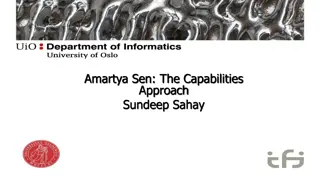
Dimensions and Meeting Diverse Learning Needs in Cultural Context
Explore the diverse demography of SAS and LED doctors in the UK, as well as complaints and fitness to practice trends among this group. Discover the challenges faced by BAME, overseas graduates, older male doctors, and non-specialist doctors in the healthcare system.
Uploaded on | 1 Views
Download Presentation

Please find below an Image/Link to download the presentation.
The content on the website is provided AS IS for your information and personal use only. It may not be sold, licensed, or shared on other websites without obtaining consent from the author. If you encounter any issues during the download, it is possible that the publisher has removed the file from their server.
You are allowed to download the files provided on this website for personal or commercial use, subject to the condition that they are used lawfully. All files are the property of their respective owners.
The content on the website is provided AS IS for your information and personal use only. It may not be sold, licensed, or shared on other websites without obtaining consent from the author.
E N D
Presentation Transcript
+ Understanding dimensions and meeting diverse learning needs Suddhajit Sen cultural
+Declaration I declare no conflict of interest Acknowledgements Geert Hofstede 2001; Culture s Consequences: Comparing Values, Behaviors, Institutions, and Organizations Across Nations. Sage publication. Gill Morrow, Charlotte Rothwell, Bryan Burford & Jan Illing (2013) Cultural dimensions in the transition of overseas medical graduates to the UK workplace,Medical Teacher,35:10,e1537-e1545,DOI:10.3109/0142159X.2013.802298
+Context Fair to refer? Reducing disproportionality in fitness to practice concerns reported to the GMC; June 2019 What do we know about Specialty and Associate Specialists and Locally Employed Doctors? GMC working paper; 9th March 2019
+The Demography SAS and LED s are a very diverse group of doctors, that make up almost a fifth of all licensed doctors in UK 54% of SAS & LED s are IMG doctors 12% are EEA doctors 52% of SAS & LED s are Black, Asian and Minority Ethnic (BAME) doctors 35% are ethnic white doctors
+Complaints and Fitness to Practice Trends: SAS & LED Doctors SAS and LEDs has a rate of complaints at 6%. This is almost half of the rate received by specialists & GPs (12%) Unlike complaints about specialists or GPs, where only a third were investigated, more than half of complaints about SAS and LEDs resulted in GMC opening an investigation
+Complaints and Fitness to Practice Trends: SAS & LED Doctors The public contribute the greatest proportion of complaints. However, just over a third of complaints about SAS and LEDs come from that source, compared to around two thirds for GPs or specialists. A much greater proportion of the complaints made about SAS and LEDs come from their employers compared to other register types.
+The Perceived Problem In particular, (BAME) doctors, overseas graduates, older male doctors and some non-specialist doctors are more likely than their counterparts to be referred to the GMC by employers or healthcare providers BAME doctors have more than double the rate of being referred by an employer compared to white doctors
+The Perceived Problem Non-UK doctors have 2.5 times higher rate of being referred by an employer compared to UK graduate doctors Under the same metric, periodic SAS and LEDs who are IMG have the highest rates of being complained about and investigated
+The Cultural Dimensions Culture- The collective programming of the mind that distinguishes the members of one group or category of people from another (Hofstede 2001) Hofstede (2001) has devised a model consisting of originally four dimensions and later six dimensions to describe National cultures Power distance (UK has small power distance) Uncertainty avoidance ( UK has very low uncertainty avoidance) Individualism vs. Collectivism (UK is high in individualism) Masculinity Long term orientation Indulgence vs. Restraint
+Power Distance You re a small God and everyone respects everything you say ( Nigeria) Back home, they perceive doctors should know everything (Jordan) In cultures with large power distance Hierarchy is important Senior doctors are not regarded as colleagues but superiors Nurses are not regarded as colleagues but subordinates Doctors are considered beyond any form of reprehension Hierarchical differences can disrupt the structure of multidisciplinary team work; where every member of the team is considered equal.
+Power Distance Doctor-patient relationship is the area with largest power distance for international graduates In my country we don t give the patients too much choice, we decide everything for them. Here the patients are deciding everything ( Syria) Patient-centred approach to medicine is an unknown concept in many cultures Communicating emotional support for patients may be a challenge for many End of life decision making has entirely different connotations
+Uncertainty Avoidance Doctors from strong uncertainty avoidance cultures may Consider their teachers/consultants as Gurus , thereby avoid intellectual disagreement Avoid eye contact while having a conversation; especially with older individuals Consider asking for help as a sign of weakness Struggle to plan their personal development goals Avoid ambiguity in clinical diagnosis Deference to authority is the norm and criticism is not offered directly
+Individualism and Collectivism Societies with collectivism produce individuals with ego effacement Doctors from those cultures are often described as reticent or subservient Doctors from countries where collectivism prevails may appear less assertive
+Human Factors affected by these Dimensions Accountability Ability Honor & Dignity Honesty
+Accountability Values and ideologies to which people are held accountable differ dramatically from one culture to the next. Perceived accountability is higher in countries with collectivist cultures Decision makers from a strong Individualistic society are primarily concerned with their own self interest The duality of blame and accountability
+Ability True ability is an individual quality, not limited by cultural influences But perception of ones ability can be obscured by self effacement/reticence, qualities associated with collectivist societies This creates a perception gap, leading to frustration and low self esteem for doctors from collectivist societies
+Honor & Dignity Honor is bound by rigid rules in societies with high power distance Honor cultures place importance on socially conferred worth and reputation Dignity cultures place importance on individual, inherent worth Certain aspects of British culture like; sarcasm or self deprecating humor is completely alien to some other cultures
+Honesty Honesty and beliefs about honesty has cultural variations According to a research by David Hugh-Jones (2015), average honesty is correlated with per capita GDP; Corporate dishonesty in recent times defied the findings of this research. It is beyond the scope of this presentation to draw inference Honesty and beliefs about honesty in 15 countries David Hugh-Jones; October 29, 2015
+Solution Providing comprehensive support for doctors new to the UK or the NHS or whose role is likely to isolate them (including SAS doctors and locums) Enhanced induction- which includes Social/cultural induction Evaluation of complaints by an impartial individual who understands diversity Promote cultural competence among doctors/supervisors working with IMG s Ensuring engaged and positive leadership more consistently across the NHS Senior leadership should have diverse representation
+Possible Research In-depth analysis of Organisational culture of NHS The Hofstede Insights Culture Compass
+Stake Holders and Responsibilities NHS trusts- Implementation of SAS charter Robust induction for SAS doctors Diverse representation in the management HEE- Training SAS tutors Promote cultural competence in supervisors GMC Implementing their own recommendations
+Further Reading An interesting source of information https://www.hofstede-insights.com/product/compare-countries/






















